Nias people
Nias people are an ethnic group native to Nias, an island off the west coast of North Sumatra, Indonesia. In the Nias language, the Nias people are known as Ono Niha; which literally means 'descendants of human'. While Nias island is known as Tanö Niha, where Tanö means 'land' in the Nias language.
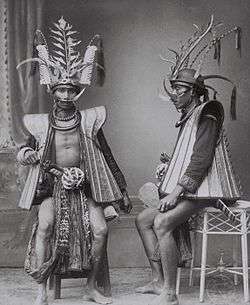 A photograph of two Nias warriors in South Nias Regency, circa 1892–1922. | |
| Total population | |
|---|---|
| 1,041,925 (2010 census)[1] | |
| Regions with significant populations | |
| Languages | |
| Nias language, Indonesian | |
| Religion | |
| Protestant Christian (predominantly) 73%,[2] Roman Catholicism 20%, Islam, Animism | |
| Related ethnic groups | |
| Batak people, Mentawai |
The Nias people are a community that continues living within the norms and practices of their indigenous culture. Customary law of the Nias people is generally referred to as fondrakö, which regulates all aspects of life from birth to death.[3] Historical evidence of megalithic structures and carvings of stones that are found in the interior of the island proved that ancient Nias people practiced megalith culture. The caste system is also recognized in Nias society,[4] whereby the highest level out of the 12 levels in the Nias caste system is Balugu.[5] In order to reach this level of the caste, one must be able to carry out big festivals by inviting thousands of people and slaughtering thousands of pigs for several days.
Origins
Mythology
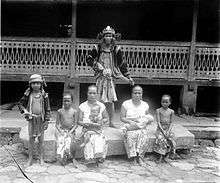
According to the people of Nias, one of the mythical origins of Nias tribe comes from a tree of life called Tora Sigaru'a which is located at a place called Tetehöli Ana'a. According to the myth, it is said that the arrival of the first human on Nias island began in the days of King Sirao, whose nine sons had been banished out of Tetehöli Ana'a for fighting over the throne. Hence the nine sons of King Sirao were considered as the first people to set foot on the island of Nias.[6]
Archaeological observations

Archaeological research has been conducted on Nias island since 1999. The observations found that there has been human habitation on Nias island since 12,000 years ago through migration from Asia to Nias island during the Paleolithic period. In fact there are indications of migration as far as 30,000 years ago. During that period the Hòa Bình, Vietnam civilization was similar to that in Nias island. Therefore, it was presumed that the origins of the Nias people came from an area in mainland Asia that is in modern-day Vietnam.[7]
New genetic research has found that the Nias people of North Sumatra came from the Austronesian peoples. The ancestors of the Nias people are also thought to have come from Taiwan through the Philippines 4,000 to 5,000 years ago.[8][9]
Research that lasted for 10 years with blood samples of 440 Nias people in 11 villages in Nias island has shown the Y-chromosome and DNA mitochondria of the Nias people are very identical to the Taiwanese aborigines and Filipino peoples. The observation has also found that the genes in today's Nias people no longer carry any traces of the ancient Nias people, as of those whose remains were found in the Togi Ndrawa cave, Central Nias. Archaeological findings of the stone tools found showed that humans living in the cave are 12,000 years old. The genetic diversity of the Nias people are very low compared to other people groups, especially with regard to the Y-chromosome. This indicates that there was once a "bottle neck" population in the past history of Nias. Studies have also found that the Nias people do not share any genes with ethnicities living in the Andaman-Nicobar islands in the Indian ocean, which are geographically considered as neighbours. Although it is known that there was a migration of the Austronesian peoples between Taiwan and the Indonesian archipelago including Nias, it is still uncertain if the migration started from Taiwan to Nias or vice versa.[10][11]
Nias clans
Nias people practice a clan system that follows the paternal lineage.[12] Clans generally come from the existing village settlements.[13]
Culture
Village and architecture

Nias people lives in highly organized villages. Nias villages often possess impressive stone monuments and large houses which stood on earthquake-resistant timber pylons. Most of these villages have lost its old houses because of their deterioration and difficulties in maintaining the ancient wooden structures from rot, insects and wear, and hence replaced by other more generic structures. Other reasons why not so many old houses were rebuilt because of the over-harvesting of the forests.[14]
In the past, Nias villages, especially those of South Nias, were strategically built on top of a ridge or hill and were surrounded by ramparts and security gates. Entry into this village was provided by only two gates via steep staircases. The gates lead to a straight paved avenue which run through the village center, with row of traditional houses on the sides of the avenue. Close to the main square of the village was the house of the village founders, the omo sebua. In Nias villages, the space in front of each houses was the property of the inhabitants. This "front courtyard" was used for mundane activities e.g. drying harvests before storing.[14]
Villages in Central Nias was usually smaller than its southern counterpart. The houses are also positioned farther away from the main avenue.[14]
Wooden figures
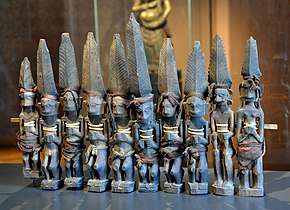
The people of Nias placed great value on wooden figures or adu. The sole purpose of the Nias figures was to fulfil ritual needs, whether it is to ensure wealth or to perform specific beneficial rite. Niassan figures vary in size, from as small as 20 centimetres (7.9 in) in height to more than 2 metres (6.6 ft) tall.[15]
When an elderly person died, the family would make a wooden statue known as adu zatua. The statue was unveiled on the fourth day after the death of the person. The shape of the wooden statue reflects the status of the person who used them: the more powerful the owner, the more impressive the statue will be made.[15] Nias people believed that the deceased person's spirits reside in the statue, so all events that occurred in the family were shared with the ancestor statues through prayers. Ancestor figures were believed to ensure fertility for the family, livestock and agricultural land. Sacrifices were made to the ancestor statues especially on important events e.g. births, marriages and deaths. Ancestor statues were placed in the main room of the house, sometimes more than a hundred. A missionary work in 1930 had recorded the removal of 'over 2000 "idols" from a house of new northern convert.' Some missionary even recorded collapsing houses under the weight of these ancestor figures.[15] Small adu zatua were bound together horizontally using a rattan and pegs.[16]
In North Nias, large impressive ancestor figure is known as adu suraha salawa (Nias language for "portraits of honored ancestors"). The adu suraha salawa represents the first known ancestor of a family, often the founder of the village.[17] The adu suraha salawa were usually placed upon a wall or on an altar (daro-daro).[16] Another large ancestor statues are the adu hörö. Adu hörö ancestor statues are large, elongated, armless and wear high, forked headdresses. These statues are generally found in Central Nias, and rarely in South Nias.[18]
Other wooden figures do not represent the ancestors. These wooden figures were created to heal specific illnesses, to protect villages, or to invoke supernatural beings to aid through rituals.[16] These statues were generally crudely made, as opposed to the finely carved ancestor figures.[18] Joachim von Brenner-Felsach classified more than 60 types of non-ancestor wooden figures.[16]
Many ancestor figures were destroyed in 1916 by a religious movement which seen them as an old blasphemous religion symbol. Some were sold to collectors and can be found in museum or private collections around the world.[19]
Stone monuments
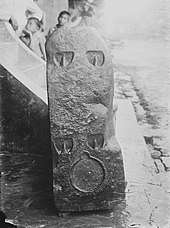
The Nias produced one of the most impressive megalith culture in Indonesia, especially the Center and South Nias. Stones were used to construct different objects and structures. Nias village features impressive stoneworks e.g. large staircases and broad paved streets. Ritual objects e.g. the behu (vertical column), standing columns, jumping stones, obelisks, altars, and sarcophagi are among the many stone objects produced by Nias people.[20]
Stone monuments were central in the owasa festival, a kind of feast to raise the rank of a person. Dedicating stone monuments publicly is considered as one of the several requirements that must be done by a person to proof that he had fulfilled the right to claim a higher rank and to receive honorary titles.[20]
The behu is a type of megalith in the form of vertical column. Behu were erected in front of the house of the host to commemorate former great celebrations held by the host. The more behu displayed in front of the host's house, the more powerful his position are in the village. Noblemen display behu that is larger in size and more abundant in numbers than the commoners. A behu with anthropomorphic form is known as the osa-osa. The osa-osa is depicted as wearing traditional Nias attire e.g. the kalabubu necklace and pendant earrings (fondulu or saro dalinga). The osa-osa's head is that of the various beasts, usually a lasara, a hornbill, a stag, or a multi-headed mixture of all. Before displaying the osa-osa in front of houses, they were paraded around the village with the host seated, or even standing on top of the osa-osa.[21]
Household objects
Nias people produce household objects carved with zoomorphic, floral, or geometric motifs. Below are a list of utilitarian objects produced by the Nias people.
- Bari gana'a: A miniature jewellery box.
- Bowoa Tanö: Clay pot
- Doghi (North Nias); fogao, dröghija (South Nias): A wooden coconut grater used to grate coconut meat to produce coconut milk or coconut oil, an important ingredients in Nias cuisine.
- Figa lae: Banana leaf used as plates
- Halu: A paddy pounder
- Haru: A wooden spoon, the base of the handle is carved with various forms e.g. a fist.
- Katidi: Weavings from bamboo
- Lösu: Mortar and pestle
- Niru: A tool to separate rice from its husk
- Gala: Tray-like item made of wood
- Sole Mbanio: A drinking container made from coconut shell
- Tumba, lauru: A tankard used to weigh rice
Weapons
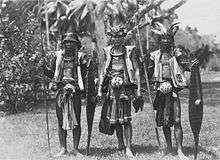
The Nias people is almost always presented as a warlike people known for their headhunting activities and human slavery, even at present time. Despite of this, none of the war-like activities are carried out by the Nias people as the majority of the Nias people has been converted to Christianity. Nevertheless, the Nias people were still known as a skillful weapon and armor-makers.
The Nias people used a variety of material for the creation of their weaponry: leather, cord or woven fibres, precious metal, iron and brass. The Nias used spears, swords and blades as their weapon. The Nias spear (toto'a doho in the south, toho in the north) was mainly used for hunting; the shaft is made of dark hardwood of nibung palm wrapped with rattan. Other type of spears are the burusa, with a triangle-shaped head.[22] The Nias sword (gari) is a combat weapon; both the sword and its sheath have simple undecorated form.[23] The most well-known of the Nias weapon is the balato or tolögu, a steel sword with a protective amulet believed to possess magical power. The balato has a hilt made of brass. The sheath of the balato contains a spherical bundle of rattan (ragö balatu) which performed as a protective amulet. This protective amulet is usually attached with a variety of objects e.g. animal fangs which is formed so that it looks like the jaw of the mythical lasara.[24] The balato is only reserved for the highest nobles as a kind of proof of the authority and the social rank of its owner.[23]
Some prominent chiefs covered their armor with sheets of gold. Helmets can be made of iron or tightly woven palm fibers. The oval-shaped shield is known as the baluse in South Nias, while the North Nias produced a hexagonal-shaped shield known as the dange.[23]
Cuisine
- Gowi Nihandro or Gowi Nitutu: Pounded cassava
- Harinake: Minced pork
- Godo-godo: Shredded cassava shaped into balls for boiling, and later with added coconut flakes
- Köfö-köfö: Minced fish meat shaped into balls to be dried or smoked
- Ni'owuru: Salted pork for longer storage
- Rakigae: Fried bananas
- Tamböyö: Ketupat
- löma: Lemang
- Gae Nibogö: Grilled bananas
- Kazimone: Made of sago
- Wawayasö: Glutinous rice
- Gulo-Gulo Farö: Candy made from distillate coconut milk
- Bato: Compressed crab meat shaped into balls for longer storage as found on Hinako Islands
- Nami: Salted crab eggs for longer storage, sometimes for months depending on the quantity of salt used
- Tuo nifarö: Palm wine
- Tuo mbanua: Raw palm wine with added laru, roots of various plants to give a certain amount of alcohol
Clothing and ornaments
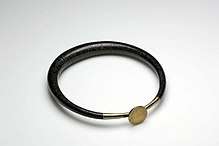
- Fondruru, men's earring made of precious metal.
- Kalabubu, also known as the headhunter's necklace.
- Nifatali-tali, a necklace of precious metal.
- Nifato-fato, a men's necklace of precious metal.
- Suahu, a comb of wood or precious metal.
Traditional proverbs
- Hulö ni femanga mao, ihene zinga ("Like a cat that eats, starting from the sides"): When doing something, start from the easiest to the difficult.
- Hulö la'ewa nidanö ba ifuli fahalö-halö ("Just like chopping the water, it will still remain"): Something that is inseparable.
- Abakha zokho safuria moroi ba zi oföna ("The wound is more severe at the later stage than the beginning"): A course of action can be felt the most towards the end.
Other traditional practices

- Fahombo: Leaping over the rock
- Fatele or Faluya or Faluaya: War dance
- Maena: Group dance
- Tari Moyo: Eagle dance
- Tari Mogaele
- Fangowai: Welcoming of guest dance
- Fame Ono Nihalö: Weddings
- Omo Hada: Traditional house
- Fame'e Töi Nono Nihalö: Given name of a married women
- Fasösö Lewuö: Bamboo competition among young men to test one's strength
Decline
Deterioration in Niassan culture already happened since the end of the 19th-century. Missionary works had contribute to the decline of original Nias culture. Missionary works in Nias such as those performed by the German Protestant Rhenish Missionary Society as well as the Roman Catholics had been responsible to the destruction of Niassan wooden statues as well the suppression of unique culture of Nias society e.g. ancestor worship, magical practices, the Owasa festivals (noblemen rank-elevation festivals) headhunting and slave trading.[14]
Notes
Bibliography
- Lase, Apolonius (2011). Kamus Liniha Nias - Indonesia. Penerbit Buku Kompas. ISBN 9789797095413.CS1 maint: ref=harv (link)
- Sibeth, Achim; Carpenter, Bruce W.; Meyers, Koen (2013). Nias Sculpture: Mandala Collection. Red & White Publishing. ISBN 9789791008723.CS1 maint: ref=harv (link)
- Suhadi Hadiwinoto (2008). Nias, dari masa lalu ke masa depan. Badan Pelestarian Pusaka Indonesia. ISBN 9791801916.CS1 maint: ref=harv (link)
- Suzuki, Peter (1958). Critical Survey of Studies On The Anthropology of Nias, Mentawei and Enggano. M. Nijhoff. ASIN B007T32XL0.CS1 maint: ref=harv (link)
- Volkenkundig Museum Nusantara (1990). Nias: tribal treasures: cosmic reflections in stone, wood, and gold. Delft: Volkenkundig Museum Nusantara. ISBN 9789071423055.CS1 maint: ref=harv (link)
References
- "Kewarganegaraan, Suku Bangsa, Agama, Dan Bahasa Sehari-Hari Penduduk Indonesia". Badan Pusat Statistik. 2010. Archived from the original on 2017-07-10. Retrieved 2017-07-18.
- Suzuki 1958.
- Suhadi Hadiwinoto 2008.
- Österreichische Leo-Gesellschaft, Görres-Gesellschaft, Anthropos Institute (1984). Anthropos, Volume 79. Zaunrith'sche Buch-, Kunst- und Steindruckerei.CS1 maint: multiple names: authors list (link)
- "Native People of Nias Island". Pleasure Surf Camp. 18 October 2014. Retrieved 2016-12-14.
- Papers, Issues 41-46. Kroeber Anthropological Society. 1969.
- "Jejak Manusia Pertama Sumatera Utara Ada Di Pulau Nias". Tempo.Co. Retrieved 12 July 2014.
- "Unexpected island Effects At An Extreme: Reduced Y-Chromosome And Mitochondrial DNA Diversity In Nias". Oxford Journals. Retrieved 12 July 2014.
- "Asal-Usul Orang Nias Ditemukan". Kompas.Com. Retrieved 12 July 2014.
- "Merunut Asal-Usul Orang Nias Berdasarkan DNA/Gen". Nias Online. Retrieved 12 July 2014.
- "MTidak Ada Kepentingan Komersial dan Tidak Ada Hak Paten Yang Akan Diajukan". Nias Online. Retrieved 12 July 2014.
- Gavin W. Jones, Chee Heng Leng & Maznah Mohamad (2009). Muslim-Non-Muslim Marriage: Political and Cultural Contestations in Southeast Asia. Institute of Southeast Asian Studies. ISBN 98-123-0874-1.
- Asian Development Bank (2010). Complaint Handling in the Rehabilitation of Aceh and Nias: Experiences of the Asian Development Bank and Other Organizations. Asian Development Bank. ISBN 92-925-4734-8.
- Sibeth, Carpenter & Meyers 2013, p. 25.
- Sibeth, Carpenter & Meyers 2013, pp. 28-9.
- Sibeth, Carpenter & Meyers 2013, p. 30.
- Sibeth, Carpenter & Meyers 2013, pp. 29-30.
- Sibeth, Carpenter & Meyers 2013, p. 29.
- "Nias Customs". Nias Heritage Museum. Yayasan Pusaka Nias. 2017. Retrieved June 20, 2018.
- Sibeth, Carpenter & Meyers 2013, p. 33.
- Sibeth, Carpenter & Meyers 2013, pp. 33-4.
- Lase 2011, p. 75.
- Sibeth, Carpenter & Meyers 2013, p. 44.
- Volkenkundig Museum Nusantara 1990, p. 298.